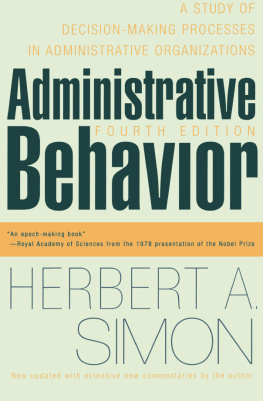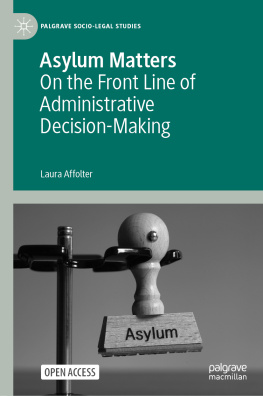
Thank you for purchasing this Free Press eBook.
Join our mailing list and get updates on new releases, deals, bonus content and other great books from Free Press and Simon & Schuster.
C LICK H ERE T O S IGN U P
or visit us online to sign up at
eBookNews.SimonandSchuster.com

CONTENTS
To D.P.S.
INTRODUCTION TO THE FOURTH EDITION
W ITH THIS FOURTH EDITION , Administrative Behavior marks its fiftieth birthday. As we are made constantly aware of the lightning speed of change in our world, we might well ask whether anything that was written before mid-century could still be true as the second millennium approaches. If our topic were electronic computers or molecular genetics, little in a 1997 edition might survive from 1947. However, our topic is organizations. Human organizations, quite large ones, have been with us for at least four thousand years. Although the physical technology a modern army employs is wholly different from the technology employed by the armies of Nineveh or Egypt or Xian, the processes people used in these ancient armies to make decisions or to manage people appear quite familiar to us and largely unchanged over the centuries. Basic organizational processes have not yet undergone a deep revolution. At most, they have just begun, in our own era, to confront major change, both social and technological.
So the task of this book, in its fourth appearance, is twofold. The first task is to describe clearly those processesdecision-making and management of peoplethat have been central to the effective operation of human organizations since their first appearance. The second task is to examine how modern technologyboth changes in social values and practices, and the new technologies of electronic communication and information processingare now changing management and decision-making. For the first task, we can rely mainly upon the original text of Administrative Behavior. To fill gaps in that text, modify some emphases, and address the new knowledge we have gained and the new problems and opportunities that confront organizations, we shall have to amplify it in considerable measure.
THE BOOKS AIMS
Administrative Behavior is basically a book for organization watchers and organization designers. As the preface to the original edition explains, the books aim is to show how organizations can be understood in terms of their decision processes. Almost all of us qualify as organization watchers, as we spend most of our waking lives in organizational environments. Many of us qualify also as organization designers, as we have managerial responsibilities of greater or lesser scope for maintaining and modifying organizations.
We are organization watchers, too, all of us, in our role as citizens. Increasing attention (and criticism) has been fixed in recent years upon the functioning of our societys largest organizations: its large corporations and its governmental agencies. Hence, this could also be described as a book for Everypersonfor it proposes a way of thinking constructively about organizational issues that concern all of us. Somewhat in contrast to current public cynicism, Administrative Behavior is generally upbeat about organizations, and although mindful of their shortcomings, it focuses on how they operate, and particularly on the conditions that enable them to operate well.
STRUCTURE OF THE BOOK
In this fourth edition, as in the previous ones, the text of the original work is kept intact, for there is essentially nothing in it that I wish to retract. Administrative Behavior has served me as a useful and reliable port of embarkation for voyages of discovery into human decision-making: the relation of organization structure to decision-making, the formalized decision-making of operations research and management science, and in more recent years, the thinking and problem-solving activities of individual human beings. Evidently, it has served a similar function for many other persons, for it continues to be widely read and cited.
But although I have no urge to recant, I do wish to augment the text considerably. In order both to develop and illustrate some of its important themes and to introduce the new issues that are of current interest and concern, extensive commentaries on these old and new themes have been appended to each of the chapters of the first edition. I think readers will find this format more coherent than the tripartite organization (lengthy introduction, original text, reprints of recent articles) of the previous edition. Anyone who wishes to stick to the basics of the first edition can read the eleven chapters and ignore the commentaries. Those who wish to confront some of the gaps in that treatment and the new topics and issues created by a rapidly changing world can include some or all of the commentaries in their reading. Many of the commentaries are drawn from articles that I have published over the years, but they have been wholly rewritten and rearranged for this new edition to give coherence to the text.
The basic organization of the book, then, may be outlined quite simply. and its commentary, it builds up five strata of topics, each of which provides a basis for dealing with the next.
(1) ) lay out some conceptual issues that are basic to the structure of human choice.
(2) construct a theory that describes and explains the realities of human decision-making, essential for understanding the influences that come to bear upon decision-making in an organizational environment.
(3) provides a motivational link between the individual and the organizationexplaining why organizational influences, and particularly the influence of authority, are such effective forces in molding human behavior.
(4) examine the main organizational influence processesauthority, communication, efficiency, and organizational loyaltyin detail in order to explain how organization affects the decision-making process.
(5) applies the analysis to questions of organization structure.
Although I have emphasized the basic continuity in human organizational behavior over the centuries, the formal study of organizations is relatively new. Administrative Behavior belongs to perhaps the second generation of modern studies of organizations, following the so-called classical theory represented by Frederick Taylor, Fayol, and Gulick and Urwick. Since the first edition appeared, there has been a great outpouring of writing and research on human relations and a persistent questioning of earlier views (of both first and second generations) about the exercise of authority in organizations.
During these same years, the study of human thinking and decision processes has also been pursued vigorously, with the result that the theory of bounded rationality that is developed here now rests, much more solidly than fifty years ago, on firm empirical foundations. Moreover, the computer has appeared and multiplied in the world of business, introducing new systems for communication and information processing. Finally, the dependence of organization structure and processes upon environment and technology is now understood with increased clarity. These are some of the new topics that are treated in the expanded text.
Administrative Behavior was written on the assumption that decision-making processes hold the key to understanding organizations. The developments noted above make decision-making even more central to organizations today than it was twenty-five years ago. It is my hope that the book, augmented by the commentaries, will continue to help those who would like to understand better and manage more effectively these complex social systems, the organizations in which we do our work.
Next page











